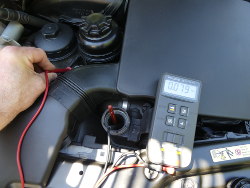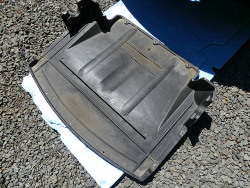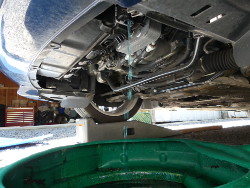Saturday, July 2, 2016
Preparation for Coolant Flush and Lift Snag
I've intentionally kept miles off the E46 for a lot of reasons but mostly so I don't have to do a lot of maintenance on two vehicles. Of course, not all maintenance is based on mileage. I recently went through my records and realized I had never done a coolant flush on this car in the 10 years I've owned it. That's a problem, of course, despite the fact the car has accumulated a mere 20000 miles, because as coolant ages it gradually looses its ability to protect against the damaging effects of electrolysis.
My brother has kept the two post lift busy since he installed it so when he let me know it would be clear this week I decided to bring the E46 in for a coolant flush. A coolant flush does not require the use of a lift, and some might argue that this is one of those messy tasks that would probably best be done outside in any case, particularly given that bleeding the system is easier with the front raised. But in this case I also wanted to do a routine inspection of the underside of the vehicle so I figured I'd kill two birds with one lift...er...stone.
I positioned the car between the posts and stepped out to move the arms in place. And that's when I realized a grievous error in selecting the Rotary SPO12-TA -- the arms equipped with the unibody adapters aren't low enough to get under the rocker covers, to say nothing of the jack pads, which are even lower. This meant, quite simply, that unless I were to engineer some kind of lift adapter that accommodates the lower ride height of the E46 I will not be able to use the lift with this car.
Out of curiosity I swapped the E46 for the E36 and realized that it would work with the lift -- but just barely -- and that the biggest problem in this case wasn't necessarily the minimum lifting pad height but rather than position of the vehicle and hence the angle of approach of the arms which would cause contact between the square portion of the arms before the lift pad mated with the jack pad affixed to the car. Lesson learned: if primarily lifting sports cars with low ride heights, select a lift with a very low minimum pad height and low profile arms. In the Rotary lineup I think the 10000 pound lifts are the largest that qualify and the in-ground version, like the one my tech has in his bay, are the best in this regard.
Coolant Flush Begins
With use of the lift out of the question I was forced to go old-school and put the front end up on my ramps to begin the coolant flush. But before I got started with the procedure I decided to do an electrolysis test. With my trusty 30 year old Fluke 12 VOM in DC voltage mode I dipped the tip of one probe into the coolant within the expansion tank and touched the other to a nearby valve cover bolt. The unit initially read 0.102 volts but this reading began to decrease slowly as the VOM impedance slowly drained the charge that had built up in the coolant (shown in the picture is one of the later readings of 0.079V) While this reading is below the maximum of 0.15V recommended for aluminum alloy blocks it was also noticeably higher than I'd seen the E36 after a full coolant flush so I knew the E46 was deserving of new coolant.
Under the vehicle I removed the underbody panel by extracting the three plastic rivets (how I hate these things) in the front and then loosened the seven quarter turn fasteners. The panel dropped down easily enough and upon its removal I became impressed with its ability to keep the engine compartment clean. It looked almost showroom new. Frankly, I wish the E36 were equipped with such a thing because the bottom of my E36's engine compartment always looks like shit no matter how much I clean it.
Incidentally, this was the first time I had seen the vehicle from this perspective so I stopped a moment to look around. Aside from the huge mechanical tensioner for the A/C belt it all looked familiar. The subframe and anti-roll bar in particular appeared lifted directly from the E36. And that's one of the many reasons I love the E46 -- it is an evolution of the E36, rather than a clean sheet design like the later vehicles, and that allows me to transfer knowledge and many special tools to this car.
I then turned the key to position two, turned the HVAC temperature control to maximum (91F), and then returned to the front of the car where I carefully removed the expansion tank cap. I donned some protective rubber gloves (not the thin disposable kind) and got under the vehicle with a drain pan and carefully removed the drain plug. The drain orifice was about the same size as the E36's radiator so I expected a comparatively slow stream of coolant and that's exactly what I got. About two minutes later the flow had reduced to an occasional drip so I reinstalled the plug. The official torque for this plug is 2-3Nm or 18-27 inch pounds. That is otherwise known as "not quite snug".
At this point I refilled the expansion tank to the maximum recommended fill level, knowing full well that I would wind up adding coolant later. I then got back in the car and started the engine before returning to the front of the vehicle. I initially expected the water level to drop in the expansion tank the second the engine started, much as it does with the E36, but this did not happen. In contrast, after about a minute of idling the coolant level in the expansion tank began to rise suddenly and eventually reached the top of the threaded collar, at which point it began dribbling down the outside of the tank. I quickly installed the cap and then loosened the bleed screw.
This is when things got interesting. After another minute or so of idling, steam suddenly began to exit the screw. I assumed this was because the E46 has an electronic thermostat and, sensing an increase in coolant temperature the DME now opened the thermostat, which exposed the remainder of the system to the very hot coolant still in the block. The steam increased in intensity, approximating that of a small tea kettle over boil, and it continued for a good three minutes before the steam was suddenly replaced with a small dribble of coolant. I took that as a sign that the bulk bleed was done and tightened the bleed screw. Total coolant refilled at this point was little more than a quart. All the while, I noticed the aux fan spool up to maximum RPM and remain there for 20-30 seconds before slowly ramping down. Clearly, the DME was responding to a spike in coolant temperature.
I decided to button the car up, pull it off the ramps, and go for a test drive. With a spare bottle of coolant mixed to 50/50 with distilled water in the trunk and one eye locked on the coolant gauge I set out on my short test loop. I manually shifted and revved the engine to over 4000 RPM a few times and quickly returned home. As I pulled into the driveway the coolant level light illuminated. Pulling up to the garage I got out and checked the level, and sure enough, the expansion tank appeared empty. As I began to add coolant I heard a few high pitched crackling sounds coming from the vicinity of the water pump which I surmised were caused by air bubbles flowing through the rapidly spinning impeller.
Total coolant added? About 2.25 quarts or a bit over a half gallon (half a bottle of BMW coolant). I compared this to the volume of coolant in the drain pain and called it even. As this clearly wasn't a full coolant flush utilizing the drain plug on the block, or the near equivalent that will result when pulling the water pump, I plan to do this again before the end of the summer in an effort to further refresh the coolant. Then I'll put it on an annual schedule. That should be more than enough to protect the engine.
Total Mileage: 19996






